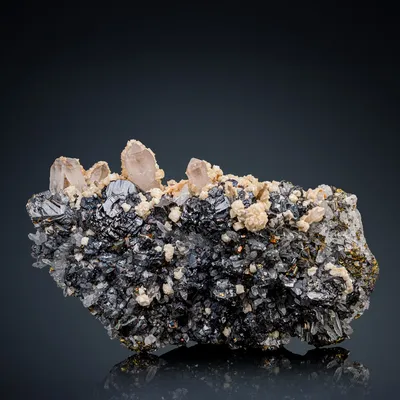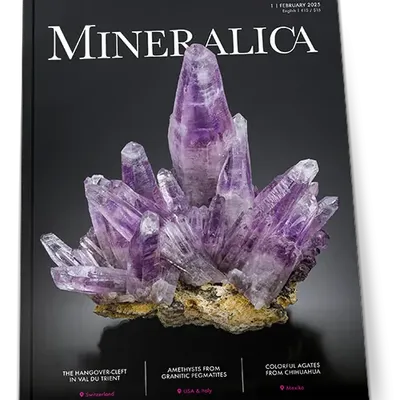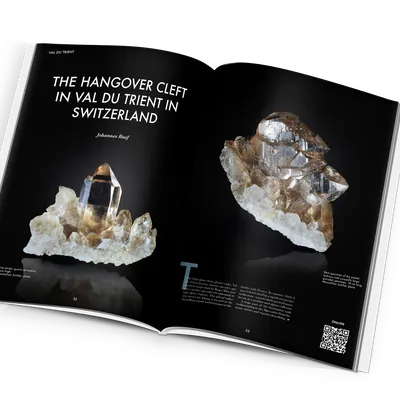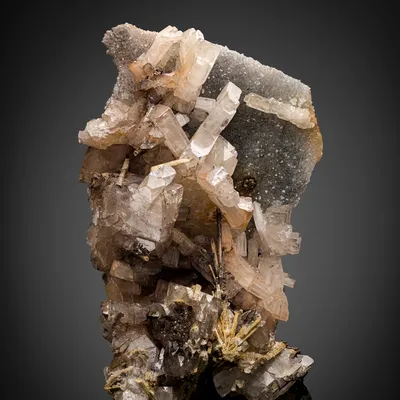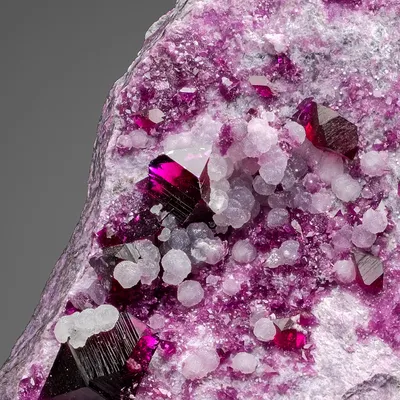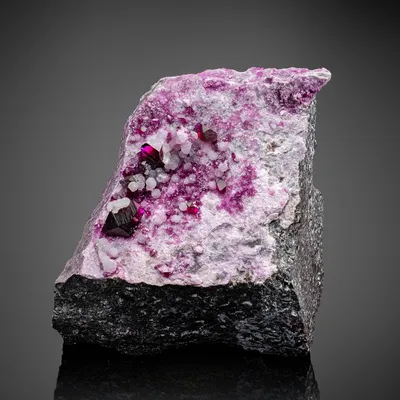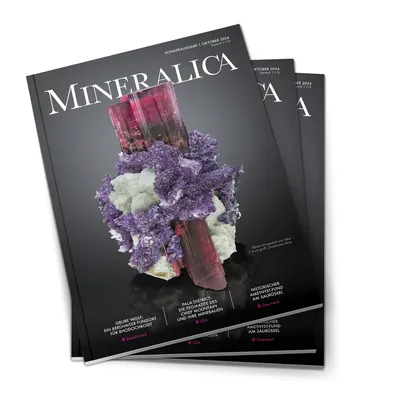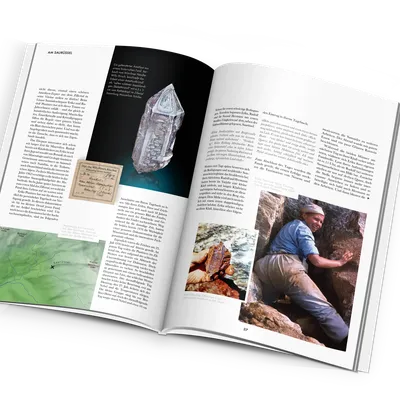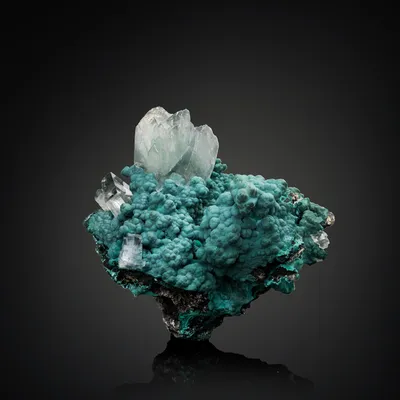Amethysts from granitic pegmatites
Amethysts are often found in basalts, quartz veins or alpine fissures. However, they are extremely rare in pegmatites, as the geological conditions often lead to the formation of smoky quartz rather than amethyst. However, there are rare exceptions.

Table of Contents
- Intro
- Deposit Types for Amethyst
- Occurrence in Volcanic Rocks
- Occurrence in Quartz, Veins, Breccias & Scarns
- Occurrence in alpine clefts
- Occurrence in granitic pegmatites
- Formation of Amethyst
- Amethyst in Granitic Pegmatites
- Pegmatite Localities
- Little Gem Mine
- Deer Hill
- Cuasso al Monte
- Other Pegmatite Localities With Amethyst
- Discussion and Conclusions
- Acknowlegements
Intro
Amongst collectors, granitic pegmatites are best-known for exceptional specimens of several colored gem minerals. These include tourmaline, topaz, most varieties of beryl, spodumene, and spessartine. The amethyst variety of quartz is seldom mentioned, but a very few deposits fghave produced world-class specimens and gem rough
Deposit Types for Amethyst
Amethyst crystals are found in cavities in deposits from a range of geological environments. Gilg (2012) identified seven such environments. Most localities can be grouped into just four of these: 1) geodes in volcanic rocks, 2) hydrothermal quartz veins and breccias (and some skarns), 3) alpine clefts and fissures, and 4) granitic pegmatites. This sequence corresponds to increasing formation temperature, though with some overlaps. It also corresponds to increasing relative degree of development of the prism faces and generally the complexity of crystal morphology. These four environments and a few best-known example localities are described in brief as follows. Of these, pegmatites are the least common sources of amethyst.
Occurrence in Volcanic Rocks
The most prolific locality for geodes in volcanic rocks (e.g. basalt) is a portion of the Paraná Basin, spanning Rio Grande do Sul Province in southeast Brazil, and Artigas Department in northwest Uruguay (Balzer 2012). Crystallization at temperatures of less than 100 °C has created druses of short-prismatic crystals of good color lining the interiors of geodes, which are up to several meters in size. Some of best specimens of amethyst have formed as stalactites and stalagmites.
In the Goboboseb Mountains in Namibia (Cairncross 2012), the productive basalt flows had uncommonly high crystallization temperatures of 150-250 °C. Generally small cavities (but exceptionally to one meter) host crystals of colorless and smoky quartz and amethyst (commonly color-zoned). Scepters and reverse-scepters are common, with amethyst commonly present in both the stem and the scepter head.
Occurrence in Quartz, Veins, Breccias & Scarns
Quartz veins and breccias, typically in gneiss, granite and quartzite, have crystallization temperatures in two ranges: less than 150 °C and 160-270 °C. A good example locality for lower-temperature veins is near Thunder Bay, Ontario, Canada (Kile 2019). Amethyst forms druses of short-prismatic crystals of varying intensity of color, some very dark due to inclusions of hematite. The deposits on Petersen Mountain (Hallelujah Junction), Washoe County, Nevada are examples of higher-temperature origin. Silica-rich hydrothermal fluids in veins and breccias in intensively fractured granodiorite have produced very fine scepters (up to about 20 cm), of smoky quartz or citrine. Amethyst is the last variety of quartz to crystallize. It is concentrated in particular portions of the deposit, where it occurs as large bulb-like crystals, less commonly as scepter heads. Skarn deposits have high crystallization temperatures, up to and exceeding 300 °C.
The skarn occurrences of Amatitlán, Guerrero State in Mexico (Ontiveros et al. 2004; Wallace 2012) were created by the intrusion of granodiorites into carbonate rocks. They have produced very fine amethyst of excellent color in prismatic crystals, some characteristically tapered. Individual crystals reach sizes of 30 cm and larger, and crystal clusters are common. No smoky quartz is present.
Occurrence in alpine clefts
Alpine clefts and fissures typically have crystallization temperatures of 200 °C and above. Example deposits include those of Las Vigas, in Veracruz State, Mexico (Wallace 2012; Lieber & Franzel 2003). The actual locality is Piedra Parada, a small community 10 km north of Las Vigas de Ramírez. It produces amethyst (but no smoky quartz) in longer prismatic crystals as a final stage of crystallization. Crystals are of light-to-medium color, stronger toward terminations. Zillertal (Ziller valley) in Austria is another example locality. In 1976, there was a major find in a 3-m deep cleft (Grüll 2024). This produced colorless, smoky, and amethystine quartz crystals to 30 cm long x 15 cm wide. Amethyst of light to medium color occurs as skeletal crystals and the heads of scepters and negative scepters. There were also rare jacaré (definition provided later) overgrowths.

Occurrence in granitic pegmatites
Granitic pegmatites are the last of the four geological environments, with crystallization temperatures for amethyst up to about 300 °C. Although this is the least productive environment, it is for several reasons the most interesting. To understand why, it is necessary to explore the requirements and especially the constraints for formation of amethyst.
Formation of Amethyst
Two chemical constituents are essential in creating amethyst: silica to produce the quartz, and iron as the chromophore to create the characteristic violet to purple color. Granite or other silica-rich host rocks are the most obvious source of the silica. In other geological environments, a silica-rich hydrothermal fluid is required, and is typically provided by the breakdown or alteration of the host or overlying rocks. As described by Kile (2012), iron replaces silicon in the tetrahedral site in quartz, at concentrations of 20-500 ppm to create amethyst. The fluid environment must be oxidizing (commonly from meteoric waters at shallow crustal levels) to have iron present in its ferric (Fe3+) valence state. Then, a source of radiation is required to convert it to Fe4+ as the actual chromophore.
Pegmatites are commonly classified based on their chemical element signatures into two families: NYF (Niobium, Yttrium, Fluorine) and LCT (Lithium, Cesium, Tantalum) (Rakovan 2008 and references therein). NYF types (which are commonly emplaced within their parent granite) are the favored pegmatite hosts for amethyst. They are generally more iron-rich with higher concentrations of radioactive elements such as uranium and thorium (in addition to potassium-40, which is present in all feldspar-bearing rocks).
But there is a crucial formation temperature constraint for amethyst, because beyond 250 – 300 °C the amethyst color center is destroyed (Kile 2012). This is the reason why amethyst is restricted to lower-temperature deposits. In pegmatites, primary crystallization (of quartz, feldspars and micas) is typically 400 °C or higher (London 2008), which is well above this 300 °C limit. Note also that lower temperatures appear to limit concentrations of aluminum, which competes with iron to replace silicon, and (also with radiation) creates smoky quartz rather than amethyst.
Crystallization in pegmatite cavities continues as they cool but, by the stage when amethyst could be expected to begin crystallizing, it appears that all available iron has already been consumed in creation of other minerals like pyrite and siderite.
Amethyst in Granitic Pegmatites
If amethyst is to be created in a pegmatite, it must be through a lower-temperature process. The favored process is alteration of pegmatite by acidic hydrothermal fluids, which are believed to be external and generally of unknown origin. This results in the breakdown of K-feldspar, which liberates silica, leaving the characteristically corroded feldspar. The same process remobilizes iron from the breakdown of hematite (as finely divided inclusions in pink K-feldspar) or other iron minerals. Pervasive such alteration of pegmatites can produce abundant amethyst, and this is the focus for the remainder of this article.
Pegmatite localities for amethyst are distinctly uncommon worldwide. A total of about a dozen individual localities and fields for amethyst are known. But only three of these have produced abundant amethyst and are sufficiently well-documented to merit full description in this article. No doubt there are other localities, which have not yet been identified or documented, likely because of the rarity of amethyst specimens.
Pegmatite Localities
The best documented amethyst producing pegmatites with the most diverse specimens are those in the extreme southeast of the Boulder Batholith in Montana, in the USA. They are located just east of the continental divide, southeast of the city of Butte and south of highway I-90. Mineral collecting likely started in the 1890s, after discoveries of gold, silver and copper. The first property to be worked, from about 1900 through the 1930s, was the Pohndorf mine (Childs & Porter 1989). Just 1.5 km to the north, is the Little Gem mine, which has been in operation from the late 1950s through to the present (Hage & Menzies 2018). Other prospects and claims lie further to the northeast, north of I-90.
The host rock is the Butte Granite, with the pegmatites (NYF types) typically found in aplite-pegmatite bodies as local segregations or tabular masses within larger bodies of aplite (Du Bray 2012). These aplite–pegmatite bodies can be as large as a few meters (exceptionally to 20 m) thick and a few tens of meters in length. Those of the Pohndorf and Little Gem are exposed over lengths of about 50 m and belong to a group of eight or nine similarly large, quartz-rich bodies, with the others having exposures that are less favorable for mining (Peter Knudsen, pers. comm. 2014). Many of these aplite-pegmatite bodies are flat-lying, with some showing a layered structure. The pegmatites show simple internal zoning, many with large, blocky crystals of microcline feldspar and a quartz core. Miarolitic cavities, exceptionally to 4 m in size, are locally common. In some of the larger pegmatites, strong late-stage hydrothermal action has produced abundant amethyst.
Little Gem Mine
The Little Gem mine, as described by Hage & Menzies (2018) is exposed for about 50 m across a steep hillside. Below the sharp upper contact with the enclosing granite, the upper (hanging-wall) section consists of alternating layers of pegmatite and aplite.

A large outcrop of milky quartz is likely part of a discontinuous quartz core, below which is a thick layer of aplite, which hosts pegmatite in small bodies and numerous veins that pinch and swell. At the base of the aplite is the lower contact with the enclosing granite.
Essentially all of the amethyst has come from the two thickest zones, which are immediately above and below the quartz core. The upper zone is a layer of coarse pegmatite, about 2m thick, consisting of and containing large (to one meter or more) columnar crystals of feldspar and quartz, and the lower zone is the up to 6-m thick layer of aplite that hosts pegmatite bodies.
All zones of pegmatite (including the quartz core) contain cavities. Many are small, to just a few centimeters in size, but can be as large as 1 to 4 meters. Cavities are most numerous in the upper zone of coarse pegmatite. However, some of the largest have been opened in pegmatite within the thick zone of aplite below the quartz core, and a sequence of very productive cavities of moderate size were opened here, just below the core.
There are two populations of cavities, primary and secondary. The first, formed during initial crystallization of the pegmatite, are either small interstices, to about 10 to 15 cm, between microcline crystals, or larger and between the faces of the large columnar crystals of microcline and quartz. Secondary cavities are those created or enlarged by alteration and partial dissolution of large crystals of microcline during localized but pervasive hydrothermal alteration of the pegmatite system. These late-stage hydrothermal fluids were highly corrosive for microcline, but not quartz; rather, the breakdown of the microcline produced silica to create a new generation of crystals of quartz. The breakdown also contributed the production of muscovite and clay minerals. In the upper workings, such cavities are found mostly between or partially within the vertically oriented host microcline crystals. In the lower workings, there are some large horizontal crystals of microcline with etched-out cavities in their lower sections. The distribution of these secondary cavities, controlled by fluid pathways through the overall body, is unpredictable, and sizes are typically much larger than most primary cavities, ranging from 30 cm to one meter, exceptionally to about 4 m. Larger examples can be irregularly shaped, commonly with offset extensions or with interconnections to form a larger composite cavity.
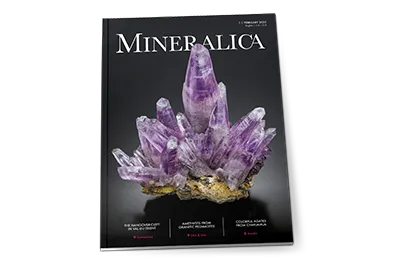
The new premium magazine for mineral collectors
4 issues per year – packed with fascinating finds, expert knowledge, and collector passion. The first bilingual magazine (German/English), including full online access.
Explore subscription
The mineralogy in the cavities in the pegmatite is remarkably simple. Quartz and microcline are the only essential minerals. Albite is distinctly uncommon in most zones. Other minerals, including products of alteration, number only seven, and most are in micromount-sized crystals. Rare epidote, schorl and anatase have been found only in primary cavities. Pyrite occurs as a few quite large crystals, typically altered to goethite and other iron oxyhydroxides. Alteration products from breakdown of microcline include green sericite (fine-grained muscovite mica) and kaolinite clay.
Quartz occurs in an impressive number of varieties, crystal habits and generations. Some of the most interesting specimens show combinations of these features. Varieties range from milky to colorless to smoky quartz to amethyst, with crystallization generally following this same sequence. Within this progression, it is common to see evidence of interruption and resumption of crystal growth. First-generation quartz in large crystals is an essential component of coarse pegmatite and quartz core, and crystal faces (including of crystal shards) can form the substrate for growth of crystals of a second generation. Amethyst represents a later-stage (and typically the last) generation of quartz. Rarely, crystallization was interrupted and then resumed, creating a distinct additional generation. Amethyst crystallization corresponding to late-stage hydrothermal alteration has created the most interesting and even unique habits of quartz. These include complex single crystals and intergrown groups, scepters and oriented overgrowths. Scepters are typically up to about 10 cm in length (exceptionally to 25 cm). Color ranges from lilac to saturated deep purple and strong color zoning including smoky quartz is moderately common. It is notable that a few small portions of pegmatite zones have intensely iron-colored microcline, but host crystals of amethyst of the palest color. Crystal luster ranges from glassy to slightly etched to frosted. One exceptional specimen is a 21-kg, 35.5-cm cluster of seven quartz crystals. The main crystal is jet-black with a thin overgrowth of amethyst on all prism faces (visible only in backlighting), but amethyst color is seen in the six smaller scepter crystals.
Secondary cavities produce the largest, most complex crystals of quartz, including those with the finest amethyst color, which are the most sought-after specimens. Typically, crystals of the best specimens have grown on the roofs of cavities, on crystals of microcline, the alteration of which has contributed to the collapse of almost all secondary cavities. Gem crystals are found loose within a mass of shards (mainly microcline but with some quartz). As an exception, in a few larger cavities in the lower workings, some of the microcline is significantly less altered, resulting in the preservation of many specimens with amethyst scepter matrix specimens in place on cavity roofs.
Some amethyst occurs in a striking pattern known as jacaré (Portuguese alligator) quartz (Frazier & Frazier 2012) as the symmetrical pattern of scutes (bony scales) on an alligator’s back resembles the parallel-growth crystal pattern created by multiple triangular (rhombohedral) termination faces and short (close to equant) prism faces. These occur as second-generation overgrowths on milky to smoky quartz, typically a single face of earlier-generation crystal exposed on a cavity wall or a crystal shard. Rarely, jacaré may form on multiple prism faces of a crystal, typically a scepter stem. Many specimens exhibit a combination of colorless, smoky and amethyst jacaré, typically with the best amethyst color at the crystal terminations. The Little Gem, and some other Boulder Batholith pegmatites, appear to be the only worldwide localities with relatively abundant amethyst jacaré. Elsewhere, amethyst jacaré appears to be very rare. Smoky quartz jacaré is more widely distributed, but still uncommon worldwide.
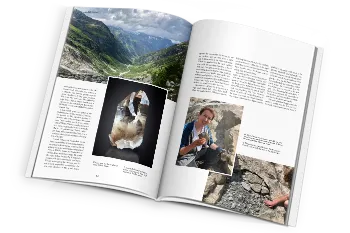
The must-have for everyone who collects minerals
Mineralica is your premium collector’s magazine – made exclusively for lovers of minerals and fossils. In print, bilingual, and with full access to the complete online library.
View issue preview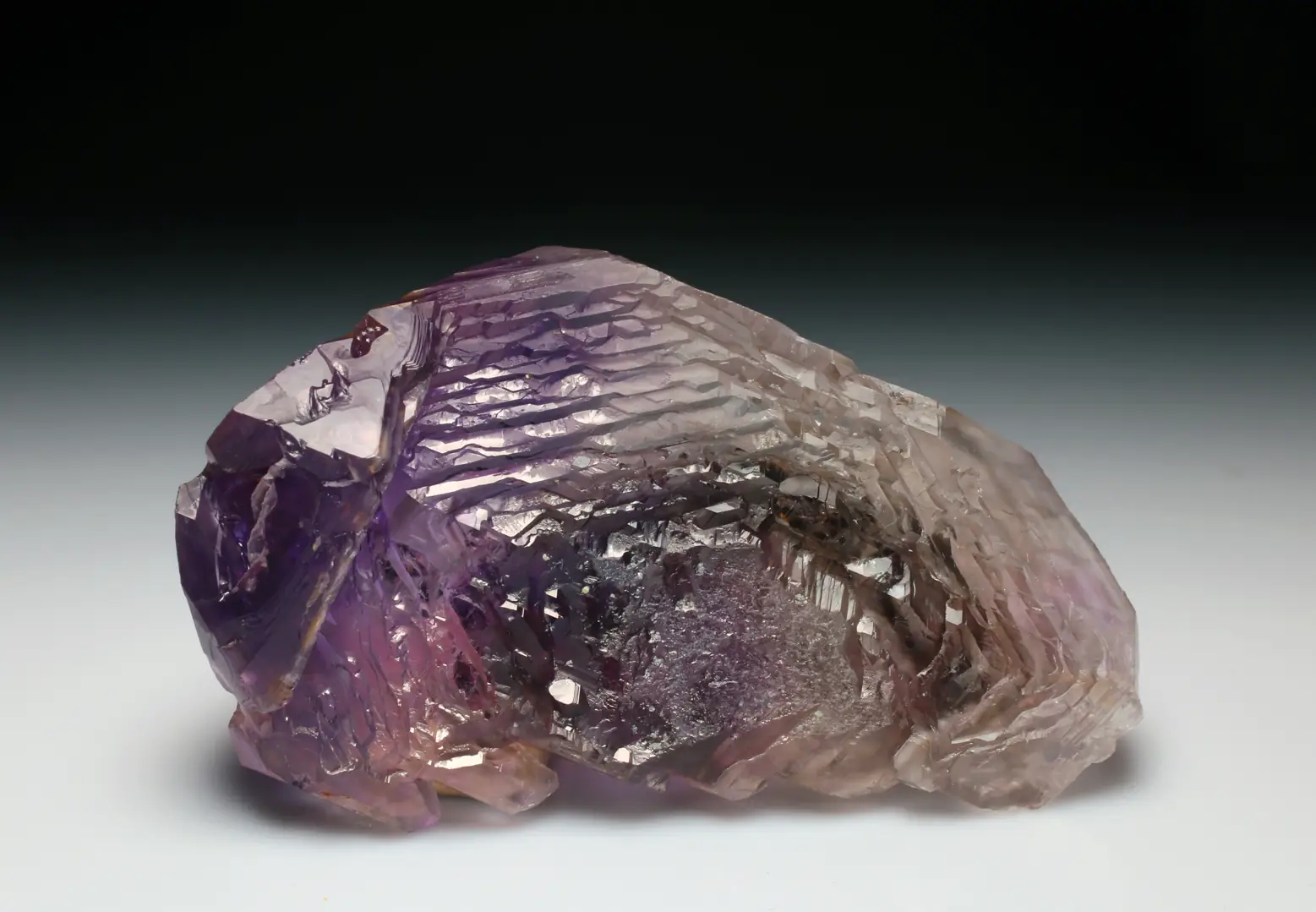
A small proportion of amethyst crystals show a striking surface texture. This consists of parallel, commonly concentric, sharp-edged and lustrous ridges 1 to 3 mm high, which resemble fingerprints. The cause appears to have been growth truncation by contact with the cavity wall. Although such “fingerprint” surfaces are flat, they do not correspond to actual faces of the amethyst crystal, but are contact surfaces to the host feldspar crystal.
Good gem rough is uncommon and mostly strongly color-zoned, but the best has produced gems to over 20 ct in size. One special amethyst gem has been found to have a small crystal of pyrite included in its center
Specimens from the Pohndorf mine are typically similar to those from the Little Gem. But some can be distinguished by examining the smoky quartz, which are characteristically heavily included with needles of black tourmaline making them opaque and black.

Deer Hill
The second major pegmatite locality is Deer Hill in Oxford County, Maine, in the USA. It lies at the western edge of the Oxford County pegmatite field, north of the small town of Stow, about 2 km from Maine’s western border with New Hampshire, and very close to the White Mountain National Forest boundary. As described by Thompson (1994), amethyst was discovered on Deer Hill in 1875. In 1883 and 1892, George Kunz, the well-known gem consultant to Tiffany & Co. remarked that the vein on the southwestern slope containing the amethyst was “fully one-quarter of a mile long” and had “furnished many thousands of crystals” but “scarcely any of them of gem value”. In 1956, there was a major discovery in a pegmatite being worked for mica and feldspar in what became known as the Eastman quarry. A 2-m, clay-filled cavity about 7 m below the surface yielded an estimated 700–900 kg of quartz crystals, 300 kg of which were amethyst. As in the earlier discoveries, most were not of gem quality, but a few crystals were deep purple and gemmy and yielded fine faceted gems.
In 1992, three Maine prospecting partners, Dennis Creaser, Gary Howard and Jay Windover, formed an enterprise whimsically called Intergalactic Mining. They leased land including the Eastman quarry, and began work about 10 m further upslope, opening a new mine they named the Intergalactic pit. Initial results were discouraging until drilling revealed a new cavity zone (Creaser 2000). They opened the cavity to a width of about 3 m and a depth of 2 m, and recovered about 1,000 kg of both massive and well-crystallized amethyst. Many of the large crystals (to about 20 cm long and 15 cm across) were embedded in white clay-like material from alteration of feldspar, and some matrix specimens were extracted from less altered pegmatite. A second major cavity yielded another 500+ kg of amethyst. Three more such cavities were opened from 1994 through 2000. In 1996, a 1.5-m cavity opened in the Eastman quarry yielded over 300 kg of crystals of amethyst, many of fine, dark color. The final discovery, in 2000, the “Millennium Pocket”, was the second-largest: an estimated 700 kg of amethyst included uncommon sceptered crystals isolated within cavity fillings. After subsequent mining produced abundant but mainly low-grade material, the mine was closed in 2013.
The pegmatite exposed in both the Eastman quarry and the Intergalactic pit is a subvertical body emplaced in granite. It has a relatively simple internal structure consisting of a wall zone, a coarse-grained intermediate zone and a discontinuous quartz core, and is composed mainly of large masses and crystals of pinkish white perthitic microcline, along with quartz and muscovite. Cavity sizes are in the range of about 10 cm to 2 m or more. The mineralization appears to have coincided, at least in part, with brittle fracturing in the cooling pegmatite, leaving the rock locally brecciated with milky quartz filling spaces between angular fragments of microcline. A fluid-flow path is apparent in some cavities, with amethyst mineralization following a “swirled” line. Quartz appears to have crystallized in the following sequence: milky long-arrow-right smoky (translucent) long-arrow-right amethyst. Amethyst occurs as massive material filling fractures within corroded microcline, and as individual crystals, groups, and rarer scepter overgrowths. Collectively, these characteristics suggest that amethyst was produced during a later-stage hydrothermal alteration event by fluids of an unknown origin.
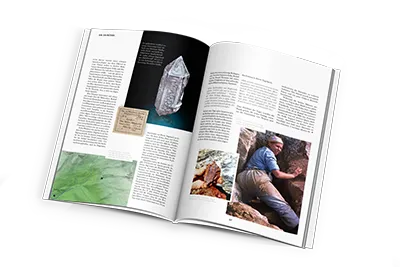
Discover more fascinating stories like this?
Mineralica brings you the most fascinating finds, places, and people from the world of mineral collectors – in print and online. A must-have for every collector.
Subscribe now and never miss an issueThe Deer Hill pegmatites have very simple assemblages of cavity minerals (similar to that seen from the Little Gem mine pegmatite in Montana), totaling fewer than ten species. The following description includes information from King & Foord (1994). Quartz occurs as crystals of several generations. Those of the first are small (mostly less than one centimeter) and milky, forming druses that line cavities and also encrust large blocky crystals of microcline or cleavage fragments. Colorless to pale smoky to amethystine crystals of a second generation are commonly deposited on this milky quartz. There may also be a later generation of quartz as overgrowing crystals in parallel orientation, which are generally colorless to only faintly amethystine. Sceptered crystals, mostly amethyst (but including some with smoky quartz) are uncommon.
Crystals of amethyst are typically equant to short-prismatic, with most from 2 to 10 cm long, but up to 20 × 10 × 10 cm. The largest single crystal recovered in 1993 weighed about 5 kg and showed several dark amethyst zones. Crystal clusters and matrix specimens, ranging in size from a few centimeters to about 50 cm, are in parallel growth or intergrown, or in densely packed masses. A few amethyst scepters are evidence of growth interruption and resumption. There are also rare amethystine crystals to about 3 cm with a pseudocubic habit. Amethyst from the 1993 find in the Intergalactic pit is considered to be the best, with a small percentage of deep purple color, and some crystals showing a reddish tinge that makes very desirable gem rough. Other crystals are pale in color but still aesthetic owing to their bright luster. Most crystals are color-zoned, commonly with a deeper color at the termination or in the interior, with the other portions pale smoky to colorless, and phantoms are common. Some crystals are fully amethystine, showing various shades of purple, and others range in color from lilac to milky white. White clay-like muscovite coats a few of the faces of some amethyst crystals.
Crystals of microcline may form the substrate for quartz specimens, but many have altered to varying degrees. Albite (cleavelandite) may form the matrix for first-generation drusy quartz. Muscovite is present as white clay-like material, which is an alteration product of microcline and filled the free space in many cavities. Other cavity minerals included a few grayish crystals of beryl, siderite in altered rhombohedral crystals, pyrite in tiny crystals and apatite.
Bradshaw (2000) reported several fine, large amethyst gems, including a 62-ct gem of medium to dark purple color and an 89-ct gem of medium purple color. Some rough was strikingly color-zoned and produced bicolored amethyst–colorless gems.
Cuasso al Monte
The third and final major pegmatite locality is Cuasso al Monte in Italy, as described by Miglioli et al. (2018). This is a village about 50 km northwest of Milan, at the foot of Monte Piambello, a 1,125-m high mountain that dominates the landscape between lakes Ghirla and Lugano. Nearby granite quarries (“cava”) include Bonomi and Gebel, both of which are still active. The Gebel quarry (formerly Bianchi, and also called Subalpina), which is the source of the amethyst, is a kilometer south of the village.
The various quarries, opened as early as 1880, have a long history. They were mined for red granite, named for its color as "Porfido Rosso", or "Porphyry of Cuasso al Monte". This stone was used initially as a building material. Then, during World War 1, the quarries supplied stone to the military for construction of military roads, trenches and fortifications. During their long operations, a major product was paving stones for roads, but they also supplied crushed rock for road construction and ballast for railways.
Good Italian amethyst is a rarity, making the specimens from Cava Gebel particularly notable. The most important finds were made in the late 1960s, with the involvement of prospectors and collectors from the neighboring Swiss canton of Ticino. These historical specimens, many of which are amethyst scepters, were extracted from large cavities in pegmatite on the upper edge of the former Bianchi quarry. Although amethyst was found in the following years, it was not of comparable quantity or quality. Then in 2014, there were another series of remarkable discoveries. These were made in the same zone as in the 1960s, which had been mostly covered with waste during the intervening period. As described by Miglioli et al. (2018), the specimens were recovered from at least seven cavities up to a meter in size.
The quarries mine red granophyre, a porphyritic, fine-grained Permian granite. This consists mainly of reddish (iron-rich) potassium feldspar and quartz, and some biotite. The texture shows larger, early-formed crystals in a finer-grained base. Miarolitic cavities (typically smaller than one centimeter) are abundant. Rarer large cavities (up to 1 or 2 m, and characteristic of NYF pegmatites) are typically vertically elongated and rooted in an aplitic-pegmatitic pod or vein. Most of these larger cavities appear to have been interconnected. Circulation of hydrothermal fluids under open-system conditions is inferred from the presence of crosscutting baryte-fluorite-quartz-sulfide-arsenate veins and local alteration of feldspar. The miarolitic cavities in the pegmatites are also well-known for rare earth element (REE) minerals and other species; more than a hundred, most typically in crystals of micro-mount size.

The most common mineral in the large cavities is quartz. Typically, it forms short prismatic crystals, some sceptered, ranging in color from milky white to gray and smoky to black. Small crystals are commonly transparent and lustrous. Amethyst in pink to brick-red color is mostly restricted to the core of the crystals, which are transparent and lustrous elongate prisms to about 10 cm. K feldspar (orthoclase) is common in well-formed, prismatic crystals that are as brown to pink to brick-red. Other species include crystals of baryte and fluorite, and water-clear, millimeter-sized crystals of topaz. Later-stage overgrowths of carbonate minerals are common.

The new premium magazine for mineral collectors
4 issues per year – packed with fascinating finds, expert knowledge, and collector passion. The first bilingual magazine (German/English), including full online access.
Explore subscriptionThe 2014 find produced abundant crystals of amethyst, almost all as scepters of medium size, averaging 4 to 5 cm in length, rarely to 10 cm. Close inspection shows that the color results from phantoms, created by amethyst and smoky zones parallel to the rhombohedral and/or the prism faces. These color zones are not evenly distributed and the most intense color occurs runs parallel to the most recently formed rhombohedral surfaces. This zoning suggests cyclical fluctuations in concentrations of iron and aluminum in the cavity fluids. With rare exceptions, amethyst is not of a particularly intense violet color. Phantom-like ivory-white deposits of kaolinite are common in the outer amethystine zone, which in turn also has a wafer-thin layer of colorless quartz. Late-stage coatings of fluorite, or amorphous silica are widespread, and reduce crystal transparency and intensity of color. Prism surfaces of the crystals are more likely to show corrosion by late-stage hydrothermal solutions. The rhombohedral faces typically have trigonal form and good luster. Scepters from Cuasso al Monte commonly show offsets in alignment of the longitudinal crystal axis, with the scepter head parallel to the stem but displaced; this may help distinguish them from scepters found in other localities. The transition from the stem to the scepter head commonly occurs in a series of steps. Inverse, multi-stepped reverse-scepter crystals are very rare.
Other Pegmatite Localities With Amethyst
Additional pegmatite localities with amethyst are widely distributed worldwide but uncommon. They have been identified by a combination of mention in the literature, specimens in the author’s collection or seen in displays at mineral shows, and information from other sources. Very little detail is available.
An exceptional specimen of two amethyst scepters with a corroded crystal of aquamarine from the pegmatites of the Erongo Mountains in Namibia is shown in Menzies & Scovil (2022) and reproduced here.
There are several occurrences of amethyst in the pegmatites of Brazil. Cassedanne & Philippo (2015) mentioned amethyst scepters on stems of milky quartz to 20 cm from a pegmatite in the Mimoso do Sul field in Espirito Santo. Also in this state, Chaves et al. (2023) reported amethyst from three pegmatite fields (Pancas, Santa Teresa and Mimoso do Sul). One specimen from the Santa Teresa field appears to be a scepter head on a short stem of smoky quartz. This field also produces rare individual specimens with seven different types of quartz: the colorless, smoky, citrine and amethystine varieties, and those with inclusions of rutile, goethite and cacoxenite.
The author’s collection includes one specimen of amethyst from the pegmatites of the Papachacra District, Belen Department, Catamarca Province in the far north of Argentina.
Federico Pezzotta (pers. commun. 2024) identified amethyst-bearing pegmatites in Madagascar in six districts, from the far north through the central regions of the country.
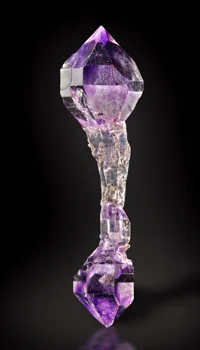
Miglioli and Weiß (2022) described amethyst in pegmatoid veins in charnockite, which is being quarried for gravel in southern India. The quarries are in the Palani Hills southwest of the city of Karur, in Tamil Nadu State. Very aesthetic but small (to several centimeters) amethyst scepters and reverse scepters, and larger sheaf- and fan-like groups to tens of centimeters have crystallized on colorless, transparent quartz. Many of the amethyst crystals have inclusions of goethite and hematite, and are associated with calcite.
Undoubtedly there are other amethyst-bearing pegmatites worldwide that are unrecognized or unreported, at least in part because of the rarity of amethyst.

The must-have for everyone who collects minerals
Mineralica is your premium collector’s magazine – made exclusively for lovers of minerals and fossils. In print, bilingual, and with full access to the complete online library.
View issue previewDiscussion and Conclusions
Anhand der Schlüsselmerkmale von Amethysten (Kristallhabitus, verschiedene Quarzgenerationen und Farbe) lassen sich das geologische Umfeld und/oder der Fundort unterscheiden.
Amethyst aus praktisch allen geologischen Umgebungen tritt in den häufigsten Kristallformen von Quarz auf. Diese reichen von Drusen mit Kristallen, die nur rhomboedrischen Endflächen aufweisen, bis zu prismatischen Kristallen. Wie bereits erwähnt, entspricht diese Entwicklung auch der zunehmenden Bildungstemperatur.
In Pegmatiten und anderen Umgebungen mit höheren Temperaturen kristallisiert Amethyst meist als späte oder letzte Generation von Quarz. Typischerweise tritt er als orientierter Überwuchs auf Kristallen einer früheren Generation auf. Die häufigste Form ist ein Zepter mit einem Amethystkopf auf einem farblosen oder rauchigen Stiel. In Umgebungen mit niedrigeren Bildungstemperaturen sind Amethystzepter weniger häufig. Obwohl sie in Basaltvorkommen selten sind, sind die Exemplare aus dem Goboboseb-Gebirge in Namibia bemerkenswerte Beispiele. In Umgebungen mit zunehmend höheren Temperaturen sind Amethystzepter häufiger, wie in den Quarzgängen des Petersen Mountain, Nevada, USA, und in den alpinen Klüften von Veracruz, Mexiko und Zillertal, Österreich. Das Vorkommen von Zeptern (oder anderen Überwucherungen der zweiten Generation) ist also nicht diagnostisch für granitische Pegmatite oder andere geologische Umgebungen.
Amethyst color of varying intensity is commonly concentrated on the rhombohedral faces. In druses of crystals where these faces are prominent, this results in a more uniform color that may be very dark. In prismatic crystals, color is more broadly (but commonly unevenly) distributed, creating distinct zoning of amethyst color and colorless quartz. The amethystine zones are commonly symmetric with the crystal axes or faces.
Higher formation temperatures, as in (but not restricted to) pegmatites appear to create higher concentrations of aluminum. This competes with iron to replace silicon in the tetrahedral site in quartz, producing smoky quartz rather than amethyst. The result is seen as zones of colorless, smoky and amethystine hues, which are commonly more randomly distributed.
Specimens from the three pegmatite deposits described in this article show a striking diversity in the types of crystallization and morphology of crystals of amethyst, as seen in the photos. Crystals from the Little Gem mine show the greatest diversity, with single crystals and intergrown groups (some with complex morphology), scepters and jacaré overgrowths.
Further amethyst-bearing pegmatites will no doubt be identified. And it will be interesting to see the characteristics of their amethyst crystals and learn how they compare with those described in this article. It will also assist in the development of a more comprehensive overview of these types of deposits.
Acknowlegements
Thanks to Mark Mauthner for his encouragement and assistance in developing this article, suggestions for improving it, assistance with editing, and sourcing of photos. Francesco Demartin and Antonio Miglioli provided very valuable help in sourcing of information and photos for the European localities. Thanks to all of the photographers for their generosity in providing photos.

























